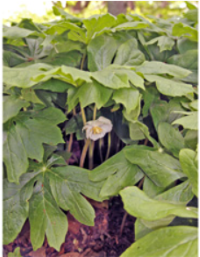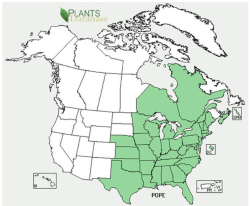Mayapple: Difference between revisions
No edit summary |
No edit summary |
||
| Line 28: | Line 28: | ||
==Species Description== | ==Species Description== | ||
[[File:Mayapple_Flower_New.png|200px|thumb|left|The map shows a fully bloomed ''Podophyllum peltatum''.<ref name= "Wisconsin"/>]] | [[File:Mayapple_Flower_New.png|200px|thumb|left|The map shows a fully bloomed ''Podophyllum peltatum''.<ref name= "Wisconsin"/>]] | ||
[[File:Mayapple_Distribution.png|260px|thumb|right|The map shows the native distribution of ''Podophyllum peltatum'' in North America.<ref name= "Texas">“Mayapple” , Foraging Texas https://www.foragingtexas.com/2007/11/mayapple.html</ref>]] | [[File:Mayapple_Distribution.png|260px|thumb|right|The map shows the native distribution of ''Podophyllum peltatum'' in North America.<ref name= "Texas">“Mayapple” , Foraging Texas https://www.foragingtexas.com/2007/11/mayapple.html</ref>]] | ||
| Line 35: | Line 33: | ||
These colonies grow from rhizomes, and grow tall stems growing anywhere between 12 to 18 inches. The stems open up and form large umbrella like leaves. The leaves branch out into 5-9 nodes, with 1 - 2 leaves per stem extending as far as a foot in length. The plant forms flowers, but only forming from plants with more than one leaf.<ref name= "Wisconsin">“Mayapple, Podophyllum peltatum” Wisconsin [[Horticulture]] | These colonies grow from rhizomes, and grow tall stems growing anywhere between 12 to 18 inches. The stems open up and form large umbrella like leaves. The leaves branch out into 5-9 nodes, with 1 - 2 leaves per stem extending as far as a foot in length. The plant forms flowers, but only forming from plants with more than one leaf.<ref name= "Wisconsin">“Mayapple, Podophyllum peltatum” Wisconsin [[Horticulture]] | ||
Division of Extension, https://hort.extension.wisc.edu/articles/mayapple-podophyllum-peltatum/</ref> The flower of the mayapple grows up to roughly 2 inches in diameter, with 6-9 white petals, and double the amount of stamens. The flower is not known to produce nectar, but produces pollen. Successful pollination rate of the plant is relatively low, and is also known to have a low rate of fruit maturation. When the plant matures, the fruit is yellow in color, egg-shaped, and contains a single berry that is roughly 2 inches long.<ref name= "Virginia">“Mayapple Plant Profile” Virginia Native Plant Society, https://vnps.org/princewilliamwildflowersociety/botanizing-with-marion/mayapple-plant-profile/</ref> | Division of Extension, https://hort.extension.wisc.edu/articles/mayapple-podophyllum-peltatum/</ref> The flower of the mayapple grows up to roughly 2 inches in diameter, with 6-9 white petals, and double the amount of stamens. The flower is not known to produce nectar, but produces pollen. Successful pollination rate of the plant is relatively low, and is also known to have a low rate of fruit maturation. When the plant matures, the fruit is yellow in color, egg-shaped, and contains a single berry that is roughly 2 inches long.<ref name= "Virginia">“Mayapple Plant Profile” Virginia Native Plant Society, https://vnps.org/princewilliamwildflowersociety/botanizing-with-marion/mayapple-plant-profile/</ref> | ||
Revision as of 13:19, 30 April 2025
Taxonomy
| Kingdom | Phylum | Class | Order | Family | Genus | Species | |
|---|---|---|---|---|---|---|---|
| Classification | Plantae | Magnoliophyta | Magnoliopsida | Ranunculales | Berberidaceae | Podophyllum | Peltatum |
Species Description


The mayapple (Podophyllum peltatum) is a species of spring ephemerals that tends to grow in large colonies. Colonies of Podophyllum peltatum can primarily be found within open woodlands, shady fields, riverbanks, and along the sides of roadways. They are native to Eastern North America, and range from southern parts of Canada and reach as far as Southern Texas.[3] These colonies grow from rhizomes, and grow tall stems growing anywhere between 12 to 18 inches. The stems open up and form large umbrella like leaves. The leaves branch out into 5-9 nodes, with 1 - 2 leaves per stem extending as far as a foot in length. The plant forms flowers, but only forming from plants with more than one leaf.[1] The flower of the mayapple grows up to roughly 2 inches in diameter, with 6-9 white petals, and double the amount of stamens. The flower is not known to produce nectar, but produces pollen. Successful pollination rate of the plant is relatively low, and is also known to have a low rate of fruit maturation. When the plant matures, the fruit is yellow in color, egg-shaped, and contains a single berry that is roughly 2 inches long.[4]
Growth and Reproduction
The mayapple begins its growth period early in the spring, and becomes dormant again by mid-summer once the leaves of other trees cover the forest canopy. The leaves of the mayapple won't begin to open until early April. The plants with two leaves on them will flower and bloom around April or May, with the flowers emitting a pungent or musky odor.[4] The flowers that become pollinated, although it is less common, will form fruits that are known to be self seeding, and will have to possibility to grow and form another colony when the soil and weather conditions are right.[1] The main method of reproduction is through rhizomes, which grow underground, and contain anywhere up to 1,000 different shoots, and grow as old as 100 years old. Because successful pollination rates are so low, a majority of the plants energy is spent growing the underground rhizome network, spending roughly 40% of its energy gained on rhizomes, and only about 8% on sexual reproduction. New colonies are primarily formed by a single seed produced by a successfully matured fruit. A new seed may not produce rhizomes for as long as 5 years after it has germinated, and may not produce any blooms until it is around 12 years old. During this time period, the plant can still grow stems containing 1 leaf, and continue to stretch out its colony at a steady rate of up to 6 inches a year.[4]
Ecological Significance
Podophyllum peltatum contains alpha- and beta- peltatin and podophylloresin. These toxins are contained within all parts of the plant, with the least toxic part for human consumption being the ripened fruit. Because of these toxins, the plant is avoided by most herbivorous mammals. However, the leaves are still consumed by animals like box turtles as well as sawfly larvae. The flower is primarily pollinated by various species of bees, moths and butterflies regardless of the low successful pollination rates. This is because the pollen is high in nutritional value, and can be a sustainable host for species like the variegated fritillary and other moth caterpillars.[5][6] If consumed, the toxins from the mayapple will cause symptoms such as diarrhea, vomiting, liver degeneration, bone marrow dysfunction, and is also known to be teratogenic, meaning that it has impacts on developing embryos in the womb. Despite the plant's toxic properties, it was still utilized in Native American cultures for natural herbal remedies, and plays a role in natural antiviral and anti-neoplastic treatments.[7]
References
- ↑ 1.0 1.1 1.2 “Mayapple, Podophyllum peltatum” Wisconsin Horticulture Division of Extension, https://hort.extension.wisc.edu/articles/mayapple-podophyllum-peltatum/
- ↑ “Mayapple” , Foraging Texas https://www.foragingtexas.com/2007/11/mayapple.html
- ↑ “Podophyllum peltatum — mandrake, May-apple” Native Plant Trust: Go Botany, https://gobotany.nativeplanttrust.org/species/podophyllum/peltatum/
- ↑ 4.0 4.1 4.2 “Mayapple Plant Profile” Virginia Native Plant Society, https://vnps.org/princewilliamwildflowersociety/botanizing-with-marion/mayapple-plant-profile/
- ↑ “Mayapple” Cornell Botanical Gardens, https://cornellbotanicgardens.org/plant/mayapple/#:~:text=Wildlife%20value,fruit%2C%20as%20may%20small%20mammals.
- ↑ “Wildflower of the Year 2025: Mayapple (Podophyllum peltatum)” Virginia Native Plant Society, https://vnps.org/wildflower-of-the-year-2025-mayapple-podophyllum-peltatum/
- ↑ “May apple” Colorado State University Guide to Poisonous Plants, https://poisonousplants.cvmbs.colostate.edu/plant/118